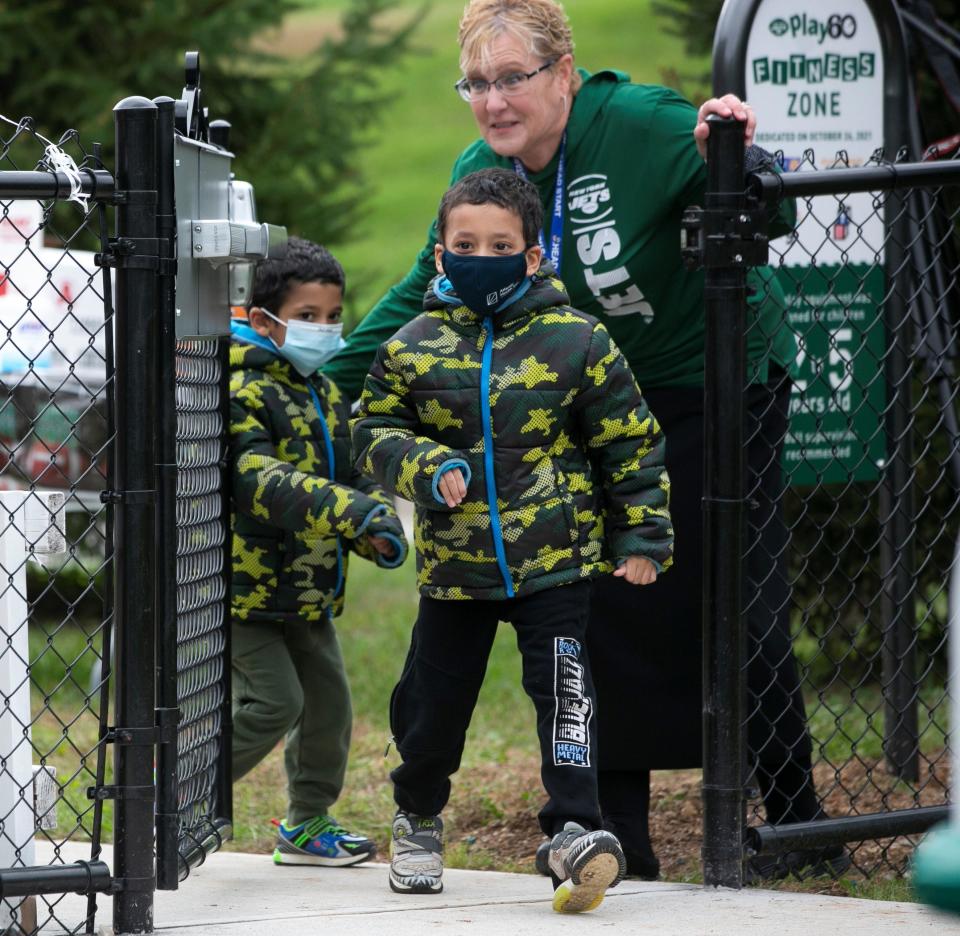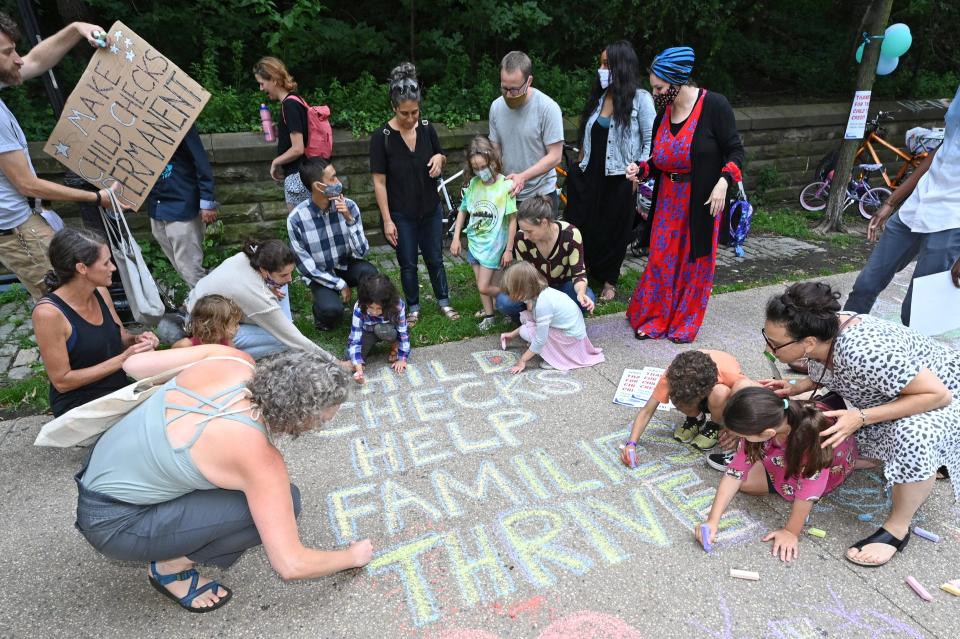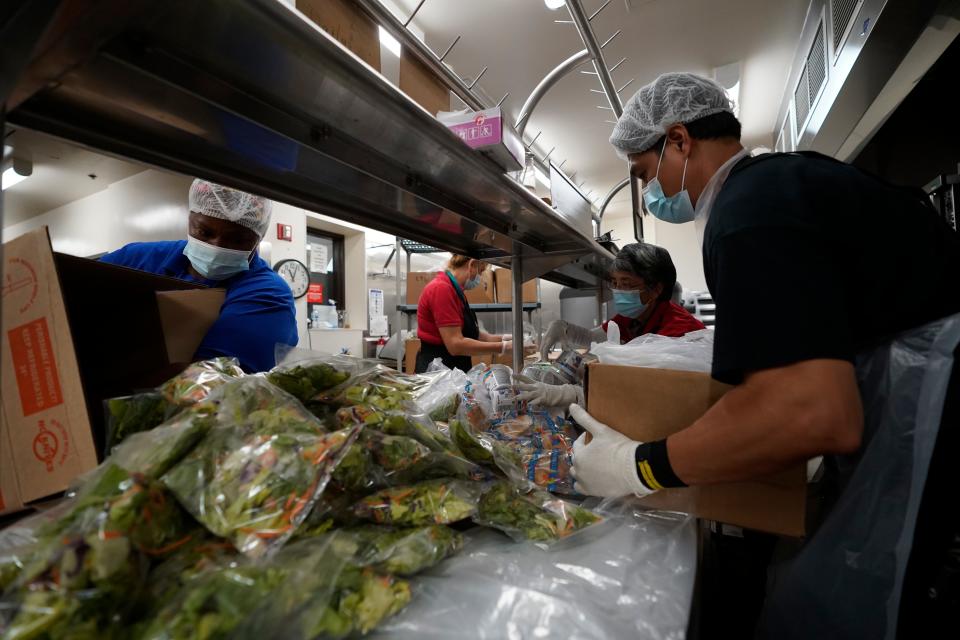Congress let COVID-era relief expire. Millions of kids already have fallen into poverty.
Amy Funes has been researching homeless shelters in case she and her 2½-year-old son, Leo, are evicted from their apartment in Queens, New York. The notice is bound to come any day now, Funes says. Her housing subsidies cover just a fraction of her $850-a-month rent.
Funes, who has a bachelor’s degree in psychology, longs to return to her career in social work as a case manager. She feels destined to help fellow single moms raise healthy, happy children while navigating the welfare bureaucracy.
But she can’t work because she can’t afford child care. And she can’t afford child care because she can’t work.
It’s a predicament that’s haunted Funes and so many parents like her throughout the coronavirus pandemic. And things are only getting worse.
A federal spending plan signed into law last week increases money for federal programs such as Head Start preschool and grants that help subsidize child care for low-income parents. But those programs reach only a small percentage of the families that need such support, advocates say.

At the same time, the social safety net that was strung underneath families during the pandemic is withering away. Expanded child tax credits, which gave parents as much as $300 a month per child, have been dead for months after Congress voted against extending them. And despite lobbying efforts, the spending plan excludes a provision that had allowed all schools to offer universal free meals.
Related video: Why child tax credit payments will look different on your 2021 tax return
Those decisions are already taking a toll, research suggests, as many parents and schools increasingly struggle to meet their children’s basic needs.
Child tax credit made a difference:How families planned to spend the extra cash
Child poverty on the rise
With all its difficulties, the pandemic actually was a time of historic drops in child poverty because of the robust social safety net, said Megan Curran, policy director at Columbia University’s Center on Poverty and Social Policy.
But as those programs have come to an end, so, too, have the gains.
A month after the enhanced child tax credit expired, 3.7 million children fell into poverty, according to a study by Curran and her team. The child poverty rate grew from 12.1% in December 2021 to 17% the next month, a 41% increase. Black and Hispanic children experienced the sharpest increases in poverty.
The February numbers, released Tuesday, show a continuation of that trend: 16.7% of children remained in poverty.
The most common item purchased with the monthly payments, by low- and medium-income families alike, was food. After just two months of payments last summer, the number of adults who said their children were going hungry dropped by several million.

In a survey in February, as the country neared two months without the checks and amid rising inflation, more than 1 in 5 parents said they could no longer afford basics such as food and housing. Another 57% said it was more difficult to meet those needs, according to the survey by ParentsTogether Action, a family advocacy organization with more than 3 million members. The vast majority of parents said they had already used all the money received through the credit.
A 'confusing and frustrating maze': COVID made finding child care even harder
Funes spent every penny of those monthly payments, using them on rent and diapers.
The former case manager was earning about $35,000 a year when she had Leo – hardly enough to cover the basics in New York City, let alone child care. Funes, 43, says she applied for child care subsidies but was told she earned too much to qualify. So, with little other recourse, Funes made the difficult decision to abandon her fulfilling, if low-paying, job with the Children’s Aid Society.
Since then, it has been one obstacle after another in her efforts to secure child care, and Funes has slipped further into poverty as a result.
Last year, Leo was diagnosed with autism, which made affordable, adequate care that much harder to find. Funes added herself to a waiting list for Early Head Start but never heard back. She reapplied for child care subsidies and was told she needed to have a job, so she took on a part-time gig at Macy’s taking home $200 a week. For a short period, the subsidies helped her afford child care while she was working. But then Funes got a notice saying her benefits were being discontinued. Again, she was told, she was earning too much.
“It infuriates me because I want to work. I’m able to work,” Funes says. But she can’t work and won’t be able to until September, when Leo starts prekindergarten. “If I work – even if I get a part-time job – they cut me off. So it’s as if they want you not to work, they want you to be homeless.”
Funes has stayed afloat for as long as she has thanks to the state’s moratorium on evictions and the monthly child tax payments. Without those, the combination of food stamps and remaining basic-needs subsidies, totaling a few hundred dollars each month, doesn’t suffice.
Which is why Funes is gearing up to move into a shelter.
In another recent ParentsTogether survey, whose results were shared exclusively with USA TODAY, a majority of parents who have struggled to find child care said they have had to cut back on hours or leave a job as a result. Forty-two percent said they had to make other financial sacrifices to afford child care – failing to pay a utility bill or rent in full, for example.
When the pandemic hit, Karen MacKenzie-Sleeman, a high school teacher and mother of four, took unpaid leave for the 2020-2021 school year to care for her youngest three boys, now ages 1, 3 and 5. MacKenzie-Sleeman, 36, and her husband, an IT professional, saved up enough to live off one income for that time.
Last spring, they started looking for child care. They couldn’t find anything near their home in Norwood, Massachusetts – infant spots were in short supply. So she decided to take another year of unpaid leave.
Child care workers are going hungry: We 'sadly fill up on cheap junk to survive'
Child care staffing crisis: Day cares are struggling to retain workers
Now, her contract requires that she return to the classroom. She wants to. She loves her job, and she’s good at it. But when she and her husband did the math, they were shocked at what they’ll have to sacrifice once she’s back at work.
Between day care for the two youngest ones and after-school fees for the two boys who are in school, 43% of their take-home pay will go toward child care, she said. Those costs will amount to twice what they owe each month for the mortgage on their single-family home.
She doesn’t know how they’re going to make it. “It’s hard to be away from your kids and not feel like you’re really coming out ahead at all,” MacKenzie-Sleeman said.
The upshot is a Catch-22 that is all too familiar to parents across the country: “If I’m not working, money’s a little tight. If I am working, money’s a little tight.”
Summer hunger
For many parents, money will become even tighter as food and gas prices climb. That trend could become compounded once child nutrition waivers expire on June 30.
The waivers gave schools flexibility in what kinds of free meals they served, how they served them and to whom.
One waiver allowed all districts to operate year-round under the summer meals program, for example, in which all students in the whole school eat free, regardless of income. Summer meals also come with a larger reimbursement from the government – about 90 cents extra a meal – than the standard free-lunch program.
Hot dog tortillas and bagged salads: School lunches take on new look amid supply-chain woes
Democrats blame Senate Minority Leader Mitch McConnell, a Kentucky Republican, for sacrificing the waivers to keep pandemic costs down. Sen. Joe Manchin, the West Virginia Democrat whose objections ultimately led to the discontinuation of the monthly child tax payments, told a reporter he was “disappointed” at the school lunch waivers’ omission. McConnell’s office says the blame is on President Joe Biden, who failed to include the waivers in his budget plan.

Either way, district officials say they could use the extra money more than ever amid rising food costs and supply chain disruptions. Without it, some may not be able to provide free meals over the summer, let alone fill positions on nutrition and food service staffs and meet nutritional requirements.
In Pennsylvania, for example, schools predict a 50% reduction in the number of summer meal sites this year. The No Kid Hungry Campaign estimates children are at risk of missing out on more than 95 million meals this summer.
“We’re at a different point in the pandemic: The health challenges aren’t as significant and, thankfully, kids are back in school,” said Lisa Davis of No Kid Hungry. “But the challenges haven’t abated – they’ve shifted.”
Combined with the end of the enhanced child tax credit, the school meal changes could leave countless families hanging. “Families that really depended on those monthly payments to help subsidize their food bills and meet the rising consumer prices are in a great deal of hardship,” Davis said.

Then there’s the added bureaucracy that will come with the return to new meal rules.
Dan Gorman, who oversees food services for a small, low-income rural district in Western Michigan, said families in his area have grown accustomed to the convenience of the relaxed pandemic-era policies. Now, meals will have to be eaten on campus: Families can’t, say, pick up a week’s worth of food to bring home to their children, even if they're sick. “In hindsight, after we’ve done that for two years, you look back at (the old rules) and realize they’re stupid,” he said.
He worries about districts having to return to their role as “gatekeepers” that effectively have to determine who’s deserving of a free meal.
The waivers allowed all districts – not just those in high-poverty areas – to serve every student a free meal, removing the typical paperwork requirements. Next school year, needy families that aren't already receiving Supplemental Nutrition Assistance Program benefits will need to apply for the subsidized meals.
Districts are scrambling to ensure everyone who’s eligible is signed up so they can finalize contracts with food vendors, a process that typically kicks off in January. Advocates worry some children will get passed over.
It's possible districts could use record COVID-19 relief money for schools to offset the changes in the school lunch program, but it's case by case, and “there’s a real lack of clarity about what’s allowed and what’s not allowed,” Davis said.
Amid low unemployment rates and other bright spots, there's often the sense that society is returning to normal. "But before the pandemic hit, there were millions of families that were living on the brink of poverty and hunger," Davis said. "And it just takes one broken car or an unexpected health care bill or a loss of some hours to plunge them from getting by to not getting by."
Contact Alia Wong at (202) 507-2256 or awong@usatoday.com. Follow her on Twitter at @aliaemily.
This article originally appeared on USA TODAY: COVID relief: Child tax credit, school lunch changes mean poverty

 Yahoo Movies
Yahoo Movies 
